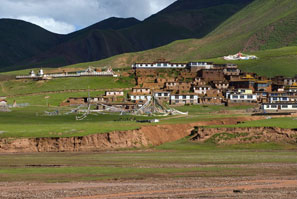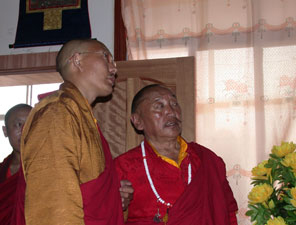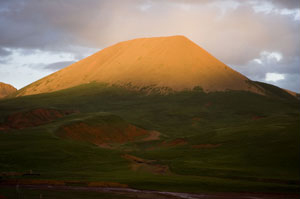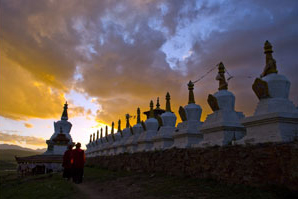

The first Lho Rinpoche, Thrinle Namgyal established his monastic seat in Dokham near the Miyel Cave, the practice place of Seltong Shogom. His monastery, in which the tradition of the Drikung Kagyu was upheld, became renowned as Lho Miyel Gön (lho mi g.yel dgon).
A hill of the mountain range of Chito Sermo Yimon in the shape of a white conch shell coiled clockwise, located in the Drongme region of Kham, became the site chosen by Lho Drubchen Tenzin Sangpo for building a new monastery. He was was one of the the incarnations of the Lho Bongtrul Tulkus.

In Tibetan “white conch” is called dung kar (dung dkar). Thus the monastery was called Lho Dungkar Gön (lho dung dkar dgon, White Conch Monastery). In the course of time this name was corrupted to Lho Lungkar Gön. It became the largest monastery of the Drongpa highlanders. The complete name of the monastery is Ogmin Thubten Shedrub Ling (‘og min thub bstan bshad sgrub gling).

The historical importance and of Lho Lungkar Gön is closely connected with the fourth Tulku in this line of incarnations, Lho Jedrung Orgyen Nuden Dorje (also known as Lho Bongtrul Changlo Mebar). He was the holder of seven transmission lineages and a most learned and accomplished master of both the Kagyu and Nyingma traditions. Born in the year of the 1849, he became the disciple of numerous learned and accomplished masters, among them the 5th Drikung Chetsang Thukje Nyima (1828-1885). Renowned for his knowledge and realization he was highly esteemed by both the Drikung Kyabgons, Chungtsang Chökyi Lodrö (1868-1906) and Chetsang Thukje Nyima, as well as by Garchen Thrinle Yongkyab. It was during the lifetime of Nuden Dorje that Lho Lungkar Gön experienced a period of flourishing.
He established yearly ceremonies for many Drubchen (sgrub chen, insensive group sadhana practice) traditions. Among those was the Drubchen of the Kabgye Deshek Düpa (bka’ brgyad bde gshegs ‘dus pa, Eight Commands, a terma revealed by Nyang Ral Nyima Oser, nyang ral nyi ma ‘od zer, 1124-1192), by following the perfect tradition transmitted jointly down through Gyalwang Rinchen Phuntsog (1509-1557) and Rigdzin Chödrak (1595-1659). In Kham Lho Lungkar Gön was the only monastery to sustain the Kabgye Drubchen in the Drikung tradition. In later years, the monasteries of Nangchen Gar Gön, Lho Miyel Gön, and Tsele Gön were also holding the Drubchen of Kabgye, which an appointed khenpo from Lho Lungkar Gön was sent to teach.

This extraordinary Dharma tradition has lately been swept under by the waves of upheaval. Nevertheless, in combination with the restoration of the monastery, the Drubchen ceremonies of Kabgye, Lama Gongdü (bla ma dgongs ‘dus), and Phurpa (phur pa yang gsang bla med) have already been re-established.

The sixth incarnation of the Lho Bongtrul Tulkus was Lho Bongtrul Tenzin Drodul. He was the root Lama of both the Drikung Kyabgons, the 7th Chungtsang Chökyi Jungne (1909-1940), and the 6th Chetsang Shiwe Lodrö (1886-1943). The seventh incarnation is the present Lho Bongtrul Tenzin Nyima (he is also the Mind incarnation of the first Lho Tsele Lhündrup).
In 1998 Lho Bongtrul Rinpoche rebuilt the historically important Lungkar Bumo Che Chörten. He later re-built Lho Lungkar Gön Monastery and added retreat centers to the complex. In addition he built a medical dispensary for the local people and founded a school for local children.

